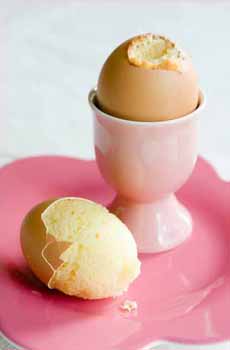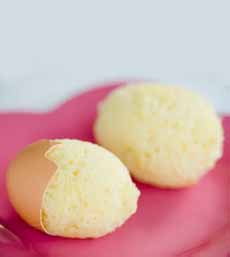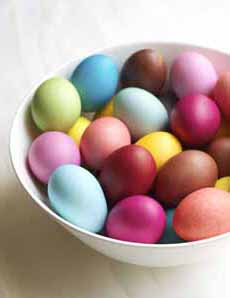TIP OF THE DAY: Make Easter Eggs Filled With Cake!
|
Steph of The Cupcake Project created a recipe called How to Make Cupcakes in Egg Shells. But, if you decorate the eggs before serving, you have Easter Egg Surprise: an egg with cake inside. It’s fun and memorable: Most people won’t have seen anything like it. Here’s the recipe. We took it one step further, using white eggs and decorating them. This protects everyone from any bacteria on the egg, and protects the eggshells from any oils on hands that may prevent the dye from adhering. We used a wide paintbrush and took the advice of Incredible Egg to use water warmer than the eggs. They also caution that hands should be washed in hot, soapy water before and after handling eggs—even if they’ve already been cooked or decorated. Because a hole has been punched into the top of the shells to insert the cake batter (photo #1), you can’t fully dip cooked cake eggs in dye (well…maybe if you use dark chocolate cake, a bit of color won’t show). Instead, you can try one of these three techniques. Or, you can color whole eggs and then bake them in the oven to get hard boiled eggs. The hard boiled eggs look and taste the same. The tradition of painting hard-boiled eggs during springtime pre-dates Christianity. Fertility and rebirth are fundamental to life—not just for people but for the crops and animals that sustain them. The most ancient known decorated eggs are 60,000 years old: engraved ostrich eggs found in Africa. Decorated eggs have also been found from prehistoric Egypt and the early cultures of Mesopotamia and Crete [source]. |
 [1 & 2] It’s an egg. No, it’s a little cake (photos © Cupcake Project). Use white eggs if you plan to color them.
|
|
|
Easter was a pagan holiday adopted by Christians; it has no relation to Christ. The Christian custom of Easter eggs began among the early Christians of Mesopotamia, who stained eggs with red dye in memory of the blood of Christ (more). The Easter holiday itself is named for the Germanic goddess Eostre (Eostra, Eostur, Ostara, Ostare, Ostern and other names), a fertility goddess. Her name derives from the ancient word for spring, eastre, She was very popular with Anglo-Saxon pagans in Brittania as well, many of whom were descended from Germanic tribes who migrated to the island. Eostre’s sacred animal is the rabbit, a symbol of fertility; and the egg is her symbol of fertile purity, both of which involve the spring and new birth. In Old German, the month of April was called Ostar-manod: Easter month, or month of the Goddess Eostre. In Old English, it became Easter-monab (pronounced eh-AH-ster moh-NATH). The English word April derives from the Latin aperire, to open (e.g. buds).
|
||




